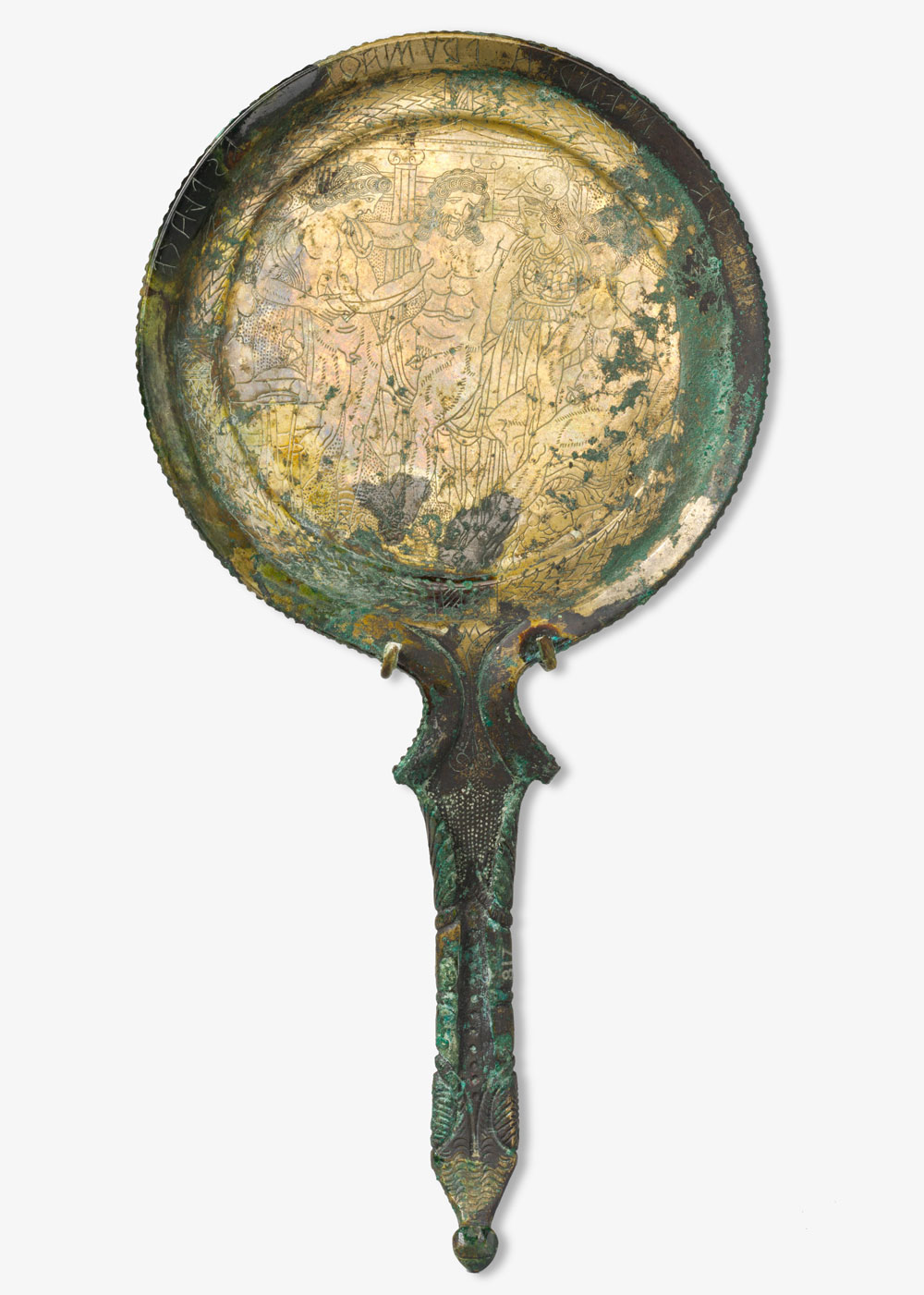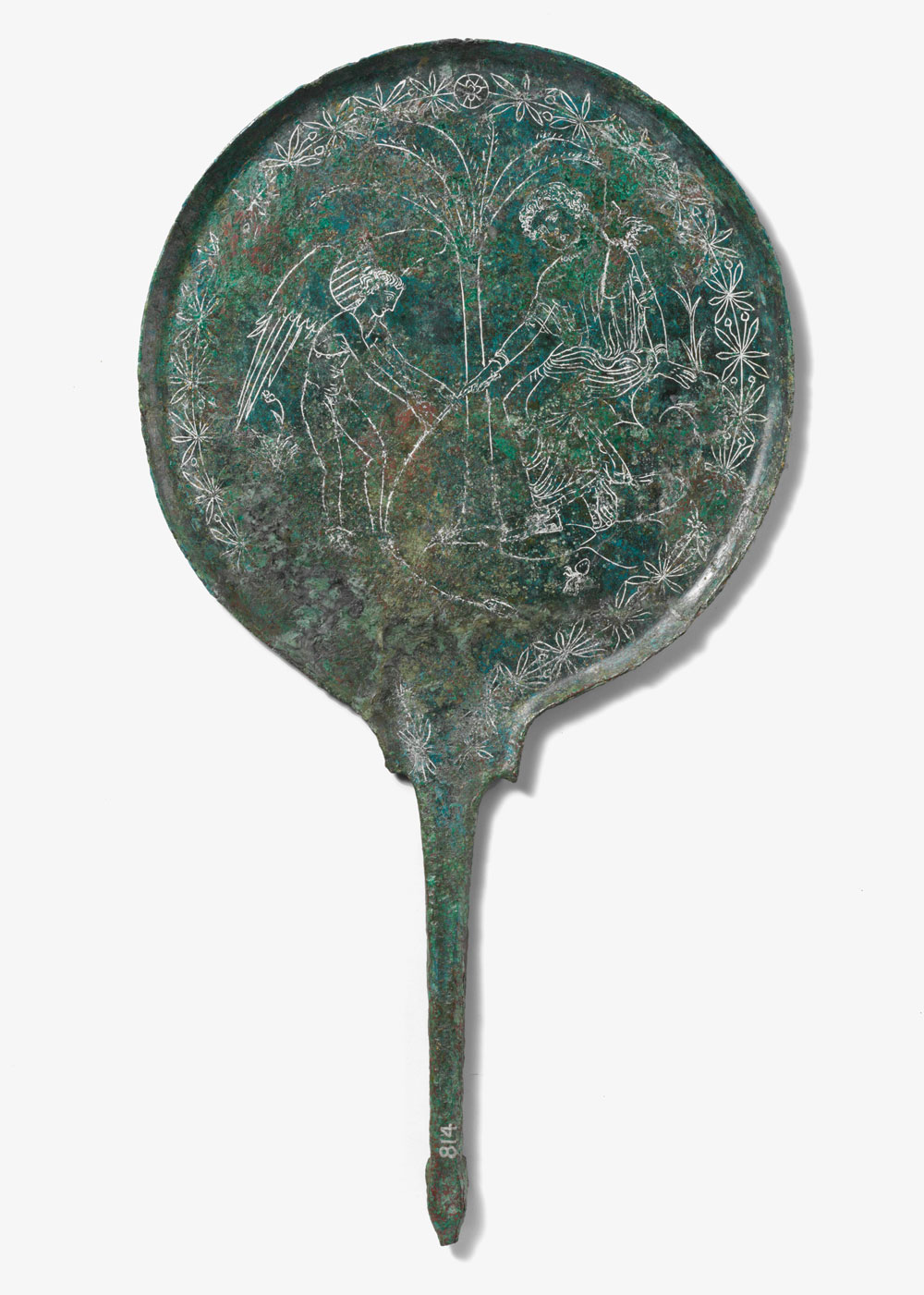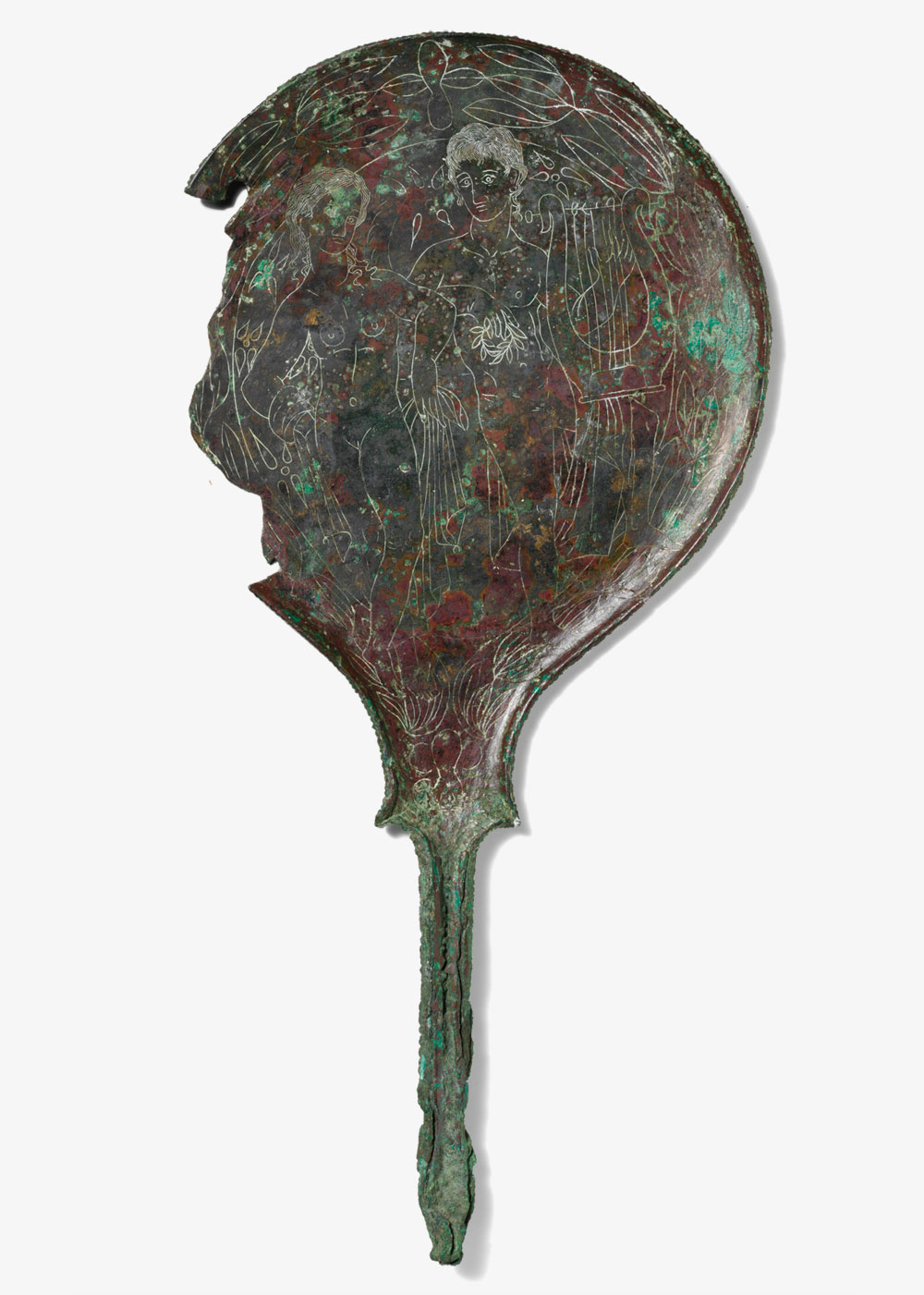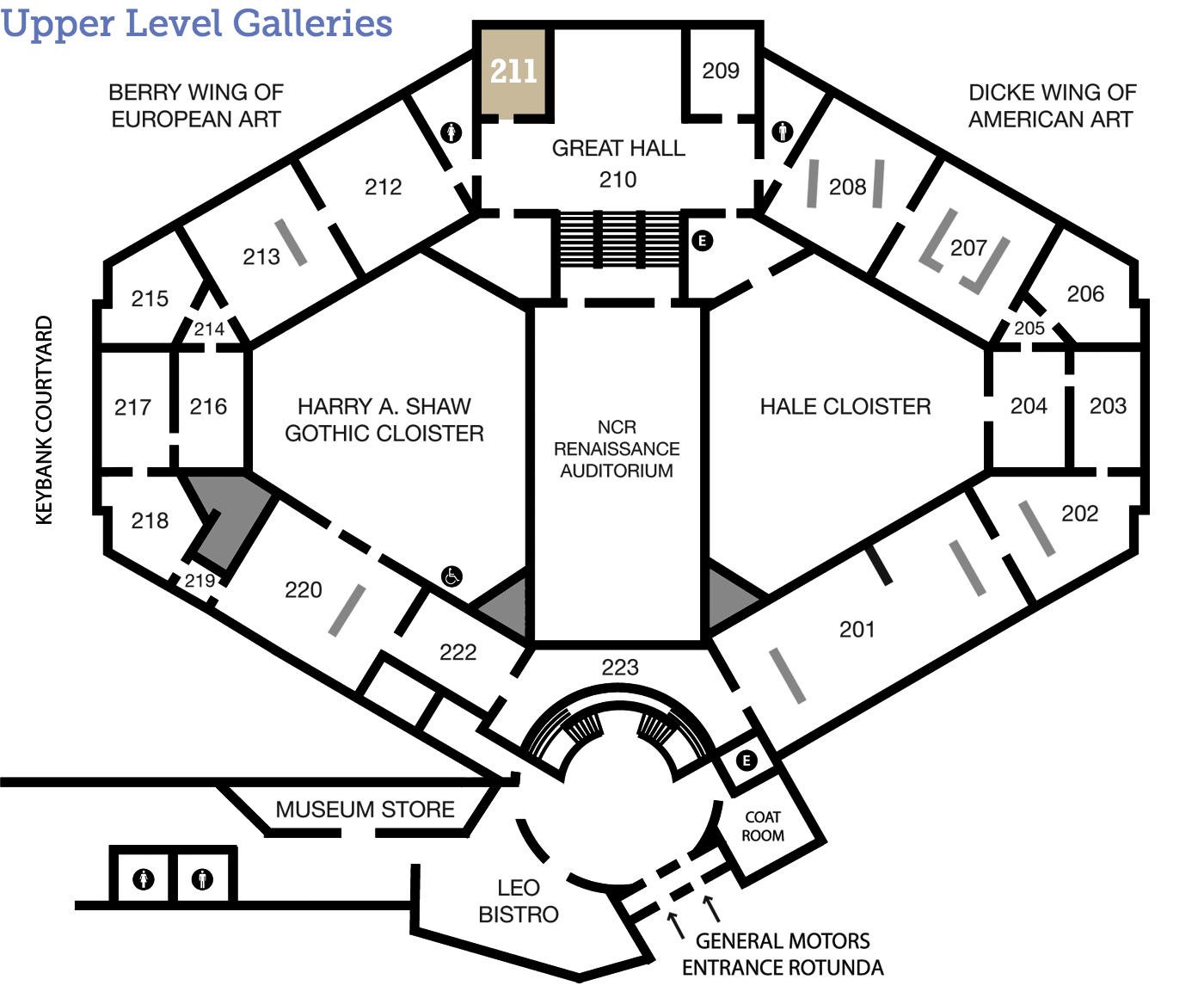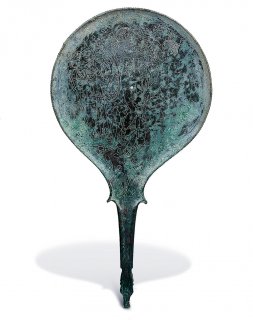
Etruscan
Hand Mirror
Bronze 13 ½ x 6 ½ x 3 inches Museum purchase with funds provided by the Zimmerman Foundation 1970.34
Reflections from the Past
Although tarnished and coated in a green patina today, thousands of years ago the highly polished surface of this bronze mirror clearly revealed an engraved mythological scene as well as the reflection of its beholder. Today, scholars look to objects like this one for insights on ancient cultures. See what our mirror can show you!
A Day in the Life
Ancient Beauty
During the 4th century BCE, a woman who held this mirror would have searched for a very specific standard of beauty in its reflection. The lady who first owned this mirror may have used it to arrange her Ionic chiton and himation. Perhaps she looked into it to groom her hair, ensuring that its loose waves were untangled or pulling it up into a knot, as was fashionable at the time. She likely admired her diadem, torque, and other jewelry, and used it to apply various cosmetics, lining her eyes with malachite and dabbing on fragrant perfumes. We think she would have been pleased if her reflection resembled this 4th-century Etruscan terracotta sculpture.

Etruscan, Terracotta Statue of a Young Woman, late 4th–early 3rd century BCE. The Metropolitan Museum of Art, New York, Rogers Fund, 1916, 16.141 (artwork in the public domain; photograph provided by The Metropolitan Museum of Art, www.metmuseum.org).
Tools and Techniques
Behind the Scenes
Look Closer
Shape Shifters
Hand mirrors found in the tombs of Praeneste often have Etruscan inscriptions, despite the fact that the city spoke a dialect of Latin. How then do we know that our mirror is Praenestine? Etruscan mirrors were circular in shape, while Praenestine mirrors were usually more pear-shaped. Can you determine which of the mirrors below are more likely Etruscan, and which are Praenestine?
Bronze mirror, early 3rd century BCE, bronze, 13 1/8 x 7 1/16 inches. The Metropolitan Museum of Art, New York, Rogers Fund, 1903, 03.24.3 (artwork in the public domain; photograph provided by The Metropolitan Museum of Art, www.metmuseum.org). |
Etruscan
|
Bronze mirror, c. 350 BCE, bronze, 13 1/8 x 7 1/16 inches. The Metropolitan Museum of Art, New York, Rogers Fund, 1907, 07.260 (artwork in the public domain; photograph provided by The Metropolitan Museum of Art, www.metmuseum.org). |
Etruscan
|
Bronze mirror, late 4th century BCE, bronze, 12 ½ x 6 3/8 inches. The Metropolitan Museum of Art, New York, Rogers Fund, 1921, 21.88.29 (artwork in the public domain; photograph provided by The Metropolitan Museum of Art, www.metmuseum.org). |
Etruscan
|
Just for Kids
Signs & Symbols
The Myths on the Mirrors
The artists of Praeneste adopted subjects from imported Greek vases to portray mythological figures. Although we are unsure what this exact image is meant to represent, as the creators of these mirrors often invented scenes that suited specific local events and their patron’s interests, we can tell that it contains the goddess of wisdom and war, Menrva (in Greek: Athena), and a Dionysiac couple, perhaps Fufluns (Greek: Dionysus) god of wine and prosperity, and his companion Areatha (Greek: Ariadne), who places a laurel crown on his head. Can you identify which figure is Menrva, which is Fufluns, and which is Areatha based on what they wear or the objects they carry?
Dig Deeper
Funerals and Eternal Life
Although Praeneste was conquered by the Romans in the 4th century BCE, close contact between the independent city and Etruria connected Praeneste with Etruscan culture and led Praenestine artists to produce numerous bronze hand mirrors. The Etruscans popularized these objects throughout the Italian peninsula; not only were such mirrors used in daily life by the elite, but they were also featured in elaborate funerary practices.
Hand mirrors were typically buried with women and were usually placed near or on the deceased's lower legs, with the reflective side facing upwards. Scholars believe the ancient peoples of Western Italy may have thought of these objects, which had once reflected an exact image of the living, as receptacles for the soul, allowing a part of the deceased to remain immortal.
Further Reading: Alexandra A. Carpino, “Reflections from the Tomb: Mirrors as Grave Goods in Late Classical and Hellenistic Tarquinia,” Etruscan Studies Volume 11, Article 1 (2008), http://scholarworks.umass.edu/cgi/viewcontent.cgi?article=1144&context=etruscan_studies.
Arts Intersected
The Sculpture Speaks
Did You Know?
Expert Opinion
Look Around
About the Artist
Talk Back
Multiple Reflections
While one might admire this hand mirror simply for its aesthetic qualities, art historians today often examine these portable goods in conjunction with trade routes, social status, funerary practices, and the economic activities of ancient Mediterranean peoples. Do you think it is important for art historians to include such information in their analyses? Why or why not?

